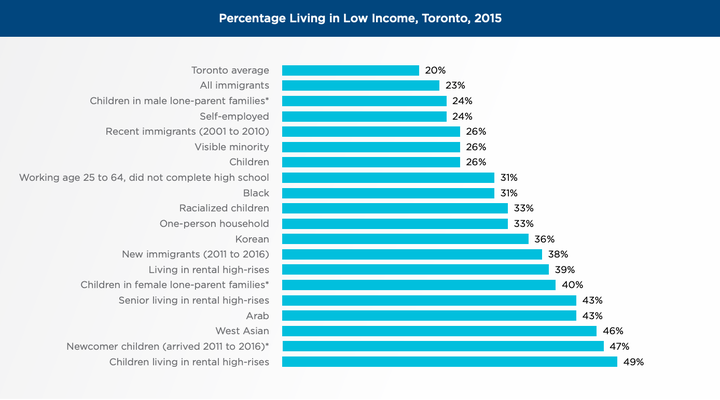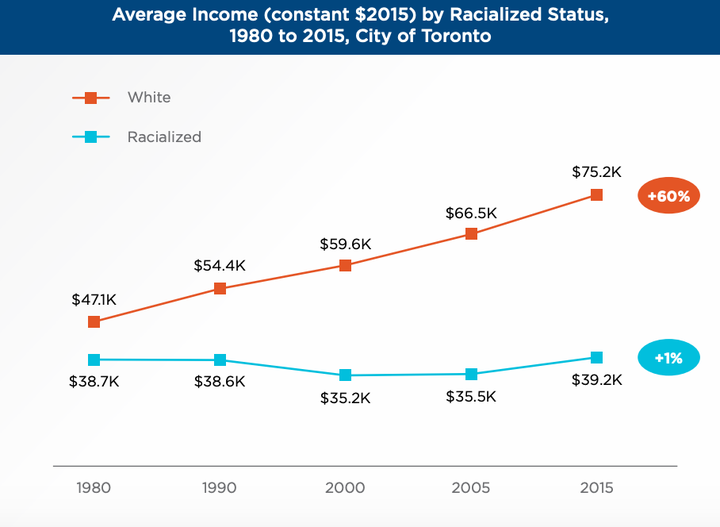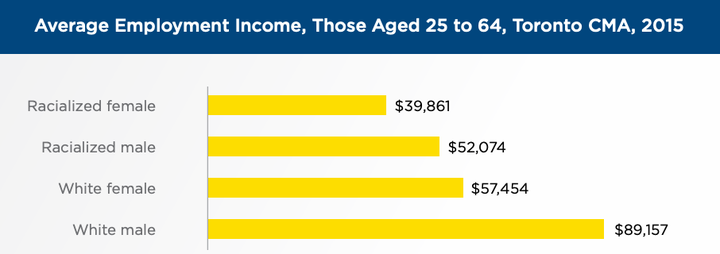It’s been known for some time that Toronto is an incredibly expensive city in which to live. But a new report from the Toronto Foundation really hammers home how tough it can be out there.
The Vital Signs report says Toronto is Canada’s working-age poverty capital, meaning it has the country’s highest poverty rates for adults who are of working age — older than 18 but not yet retired. It’s not doing much better for other people either: it has the second highest poverty rate in Canada for both children and seniors. Only Winnipeg has higher child poverty rates, and Vancouver has higher senior poverty rates.
Earlier: Immigrants in Toronto today are earning less than newcomers in 1980. Story continues after the video.
David Hulchanski, a professor at University of Toronto’s Faculty of Social Work, had some of his research included in the report. He said Toronto’s working poor level has been increasing over the past 10 years.
“[It means] adults working full-time or almost full-time and not earning enough to clear the poverty level, not earning enough to live on for themselves or their families,” he said.
The divide is also highly racial, and hits Black Torontonians particularly hard.
“More and more people having jobs that don’t pay enough to live on. And then it’s highly racialized: a smaller percentage of white Torontonians are among the working poor but for racialized groups it’s much higher and then for the Black population of Toronto it’s even higher,” he said.
“It doesn’t matter whether you’re an immigrant or Canadian-born when it comes to the Black population but it does matter to other groups.”

For working-age adults, Toronto has a lot of challenges. While unemployment rates are dropping and the city’s gross domestic product grew by 3.2 per cent annually between 2011 and 2016, income inequality is worse than ever. In fact, Toronto has the most income inequality in the country.
Over half a million people live in poverty in Toronto, and rates are higher in marginalized populations like Indigenous people, racialized communities, and newcomers.
“We need to talk about segregation and discrimination more than we currently do.”
- David Hulchanski
Different groups in Toronto have dramatically different experiences: over the past 35 years, white people in the city have seen their income grow 60 per cent while racialized people have only seen theirs grow one per cent, the report states. This difference could be in part due to the growth of non-standard (contract, temporary) jobs that often go to racialized populations and newcomers. When gender is taken into account, the difference becomes even more stark. The report says that in 2015, a racialized woman in Toronto had an average annual income of $39,861 while a white man had an average of $89,157.
“What the labour market pays people is vitally important and compared to 30 or 40 years ago, there’s just way more part-time jobs, jobs without benefits, minimum-wage jobs… And of course the rise of the so-called gig economy,” Hulchanski said. “People are doing their best to scrape a living together.”

Toronto is also growing into a more segregated city, due in part to this growing difference in wealth.
“In high-income neighbourhoods, 73 per cent of residents are white compared to only 31 per cent in low-income neighbourhoods,” the report notes. The number of middle-income neighbourhoods are also shrinking, with more and more Torontonians falling into either the high or low groups.
“We need to talk about segregation and discrimination more than we currently do,” Hulchanski said.
“Despite our self-image, Toronto does not work for all. In fact, for a growing majority, life in the city poses a serious struggle, and the trend lines suggest things will get worse before they get better,” Sharon Avery, president and CEO of the Toronto Foundation, said in a press release. “We’ve compiled more data than ever before and the evidence is clear: inequality is the new normal.”

In terms of housing, the situation in the city is unsustainable for many. House ownership costs have grown four times faster than income, while rental costs have grown twice as fast as income. The number of new rental units has also not kept up with the how fast the city’s population is growing.
Torontonians pay more of their income on rent than most other Canadians, but the report points out that they also make about $4,507 less than their counterparts in other parts of the country. Most financial experts recommend spending no more than 30 per cent of household income on housing — 76 per cent of Toronto renters making under $50,000 a year in their household spent much more than that on a place to live. The city’s official count of homeless people in shelters has grown a staggering 69 per cent in just five years.
“Indigenous peoples, racialized populations, including Black people, LGBTQ2S+, and transgender people, are far more likely to be homeless,” the report states.
“There’s this huge disparity between what white and non-white people earn and where white and non-white people live,” Hulchanski told HuffPost Canada.
“There’s a much greater opportunity right for some people based on geography and income alone but also gender.”
- David Hulchanski
He explained that growing up in a wealthy neighbourhood is linked to future success and wealth because children that grow up in those areas have more resources, their parents have the means to spend more time with them, and they’re surrounded by wealthy people to network with which perpetuates the cycle of wealth inequality. Black Torontonians, for example, are highly segregated to two major areas: north Etobicoke and Scarborough, and that correlates to their chances of growing their wealth in the future.
“There’s a much greater opportunity for some people based on geography and income alone but also gender.”
“The old ways aren’t working. New voices and new actors are needed at the table to fight inequality,” Avery also noted.
Part of why the situation in Toronto is so grim is because the city is growing at such an accelerated pace — its population is growing at the fastest rate in North America, so problems that affect communities across the continent are even more stark.
Watch: Torontonians talk about the impact of soaring housing costs. Story continues below.
With all these issues, it’s no wonder Toronto is probably Canada’s unhappiest city, especially for young people, according to the report. Still, it’s not all bad news and the Toronto Foundation also makes sure to highlight organizations striving to make positive change in the city so the report’s readers can support them. It also lays out policy changes that government can enact to promote improvement.
Mainly, new residential buildings designed primarily for renting must be built, but short-term rentals need to be regulated as well. Another suggestion is making sure developers have incentives to build units that are profitable but also help deal with the city’s housing crisis. It also recommends legislating more health benefits and employment insurance for people in precarious jobs.
Democratic system needs to change
Hulchanski also said that change needs to happen in our democracy for things to improve. The first-past-the-post system is flawed because it allows a party without the majority of votes to hold the majority of seats and often make decisions that most voters don’t agree with.
Locally, Hulchanski thinks change is even more needed — and that ranked ballots are the way to go.
“We have a number of great candidates running in many of the wards or districts and a few of them could be similar and they split the vote and somebody the majority doesn’t like happens to win,” he said.
“Introducing ranked ballots at the municipal level, which is a current campaign that a number of people are promoting, will help a lot and produce a more representative City Council.”
Something does need to change, however. Inequality was lessening into the ’80s and ’90s, Hulchanski said, but something shifted and we started to move towards greater inequality — inequality fosters anger, and leads to people taking that anger out through violence instead of organizing democratically.
The 2019 Vital Signs report was released by the Toronto Foundation and looks at the big picture through a study of nearly 300 data sources. Along with income and housing, the report also analyzes the state of Toronto in the categories of work, culture, environment, transportation, civic engagement, health, learning and safety.
CORRECTION: A previous version of this story had an incorrect qualifier for David Hulchanski.